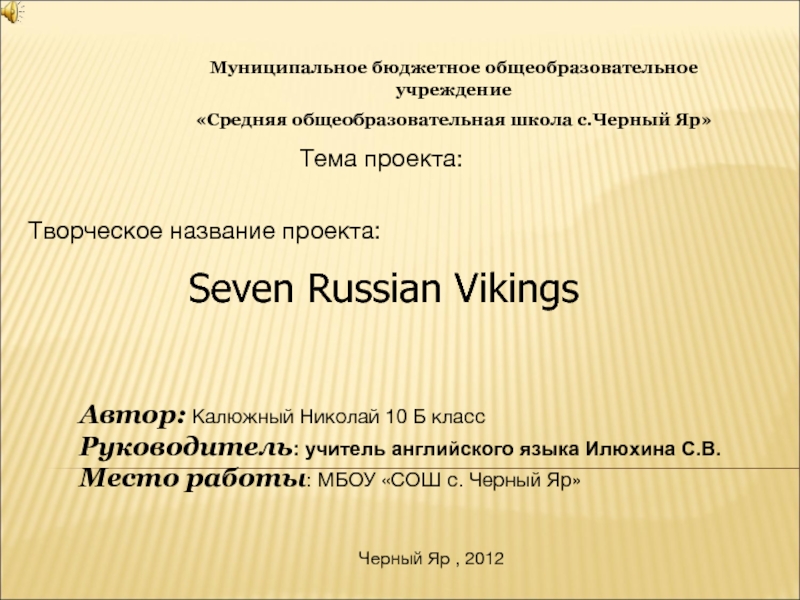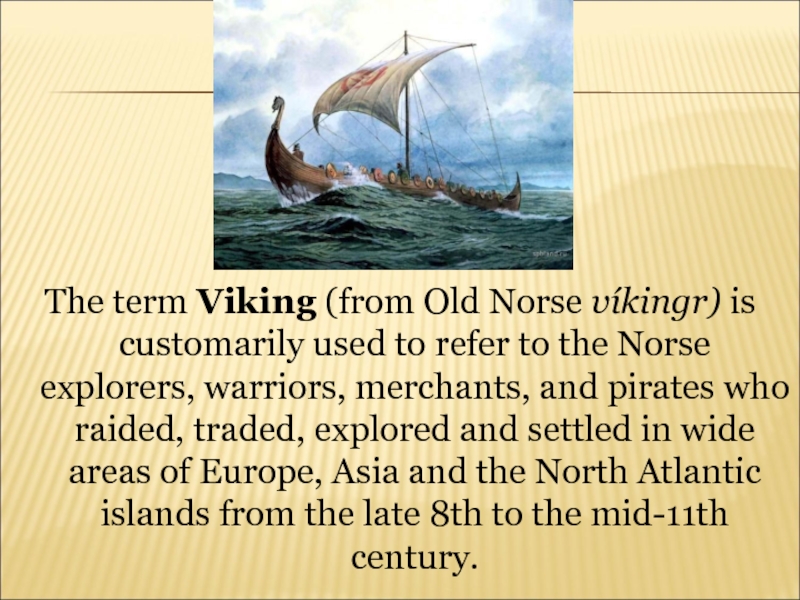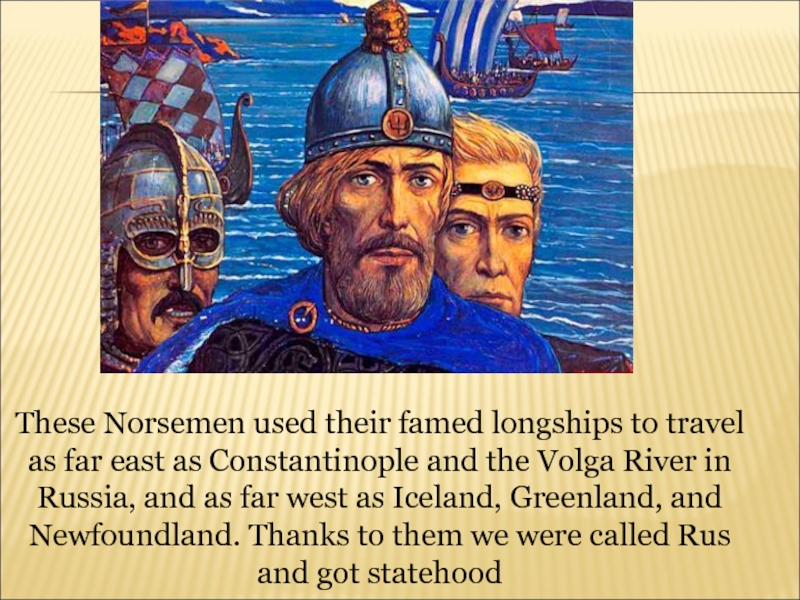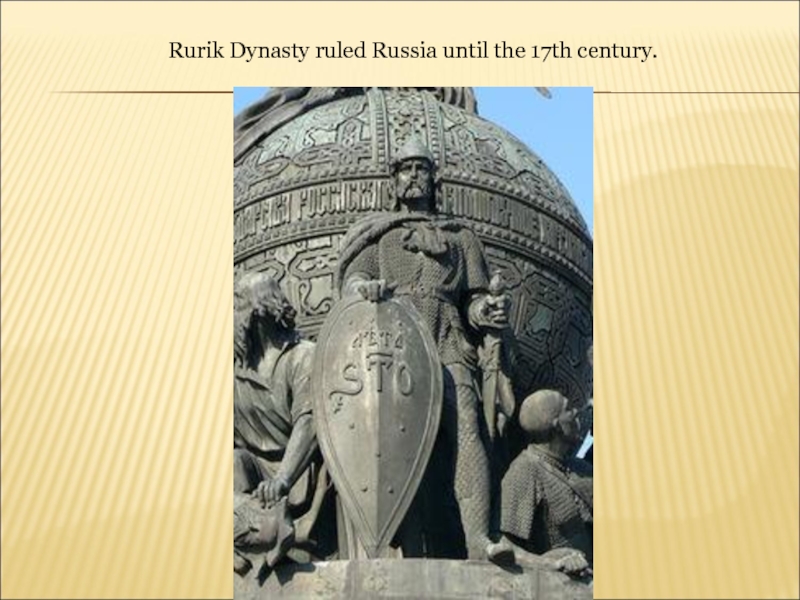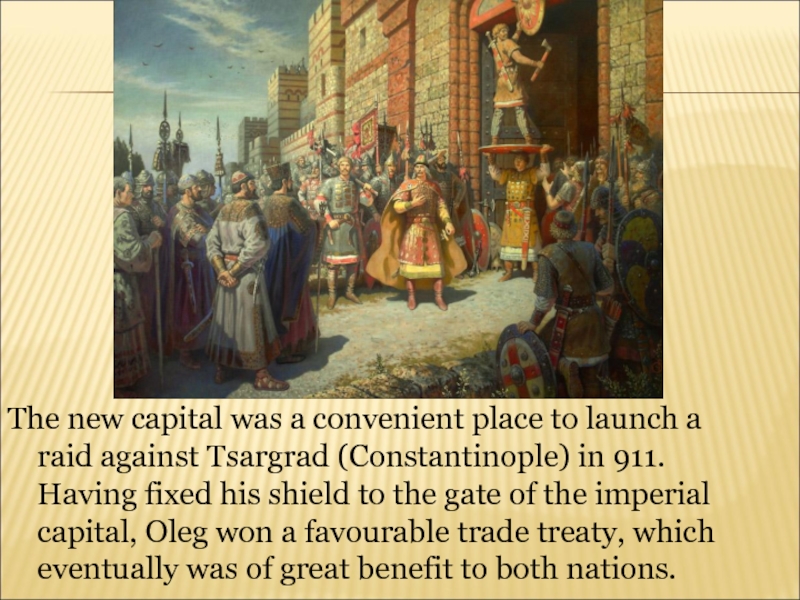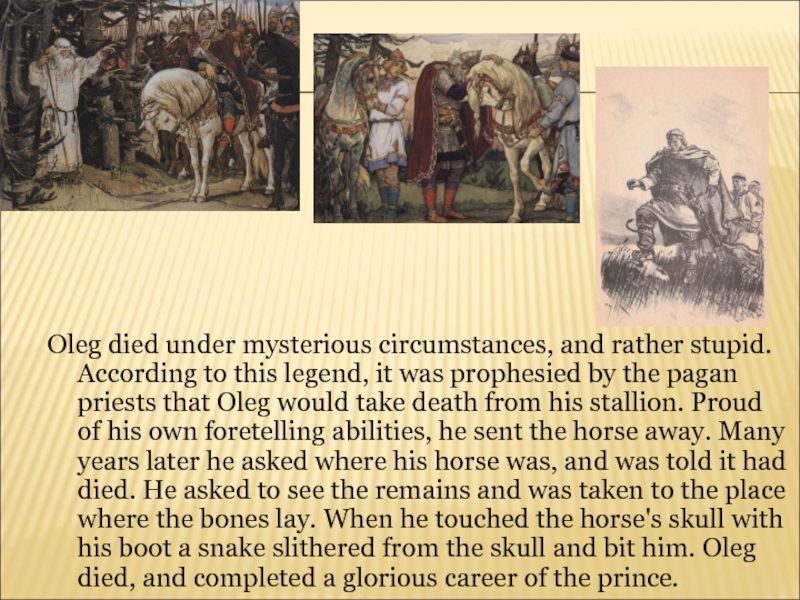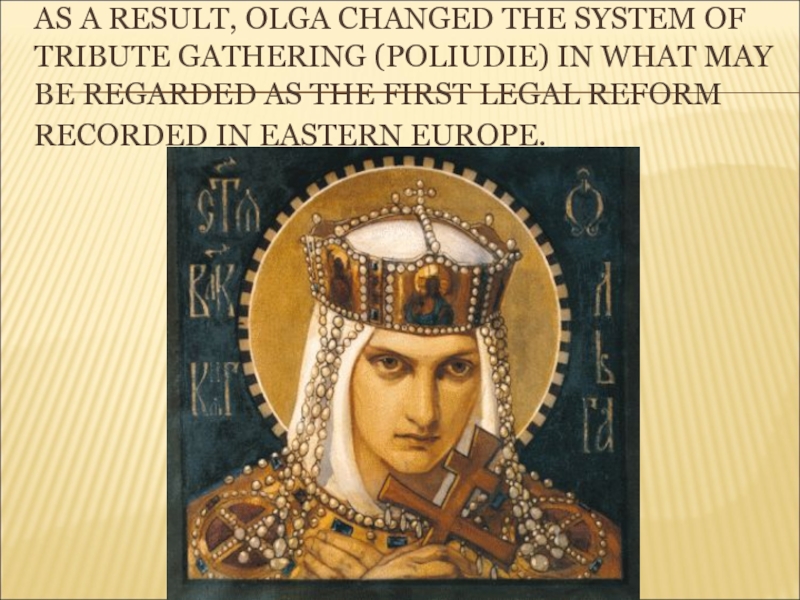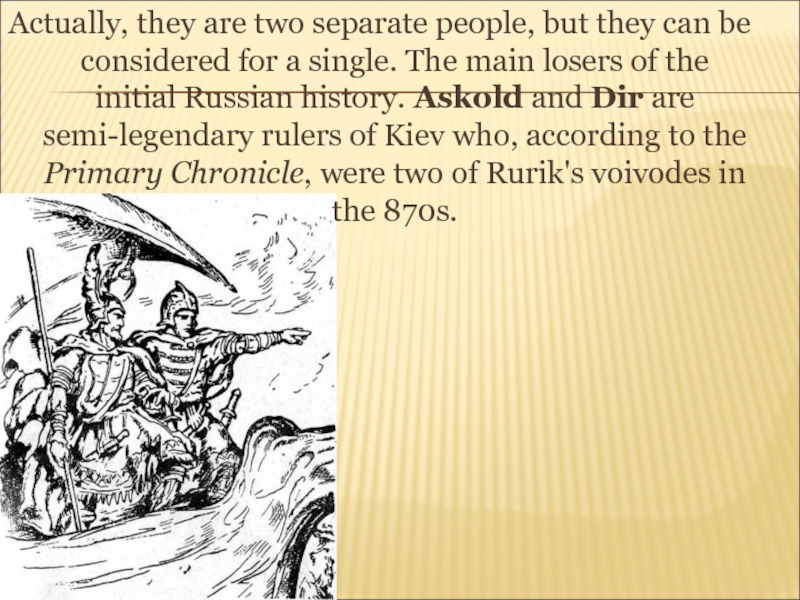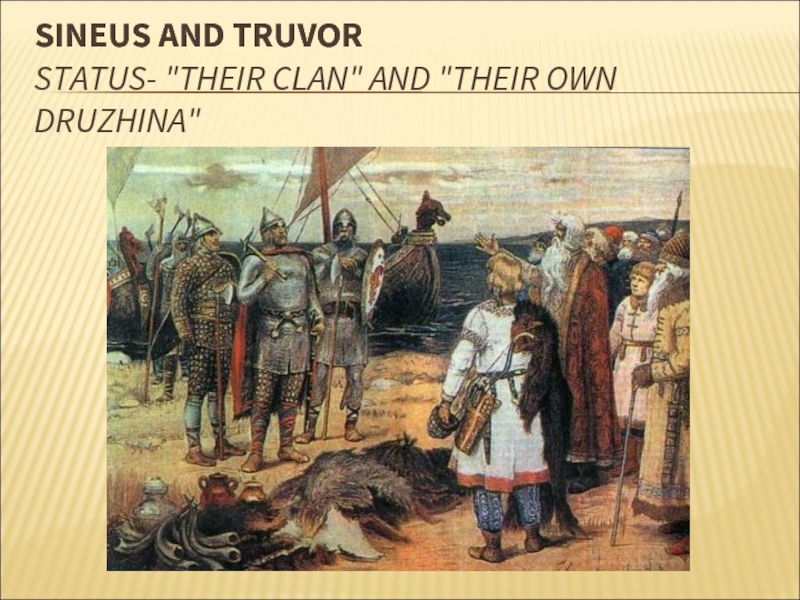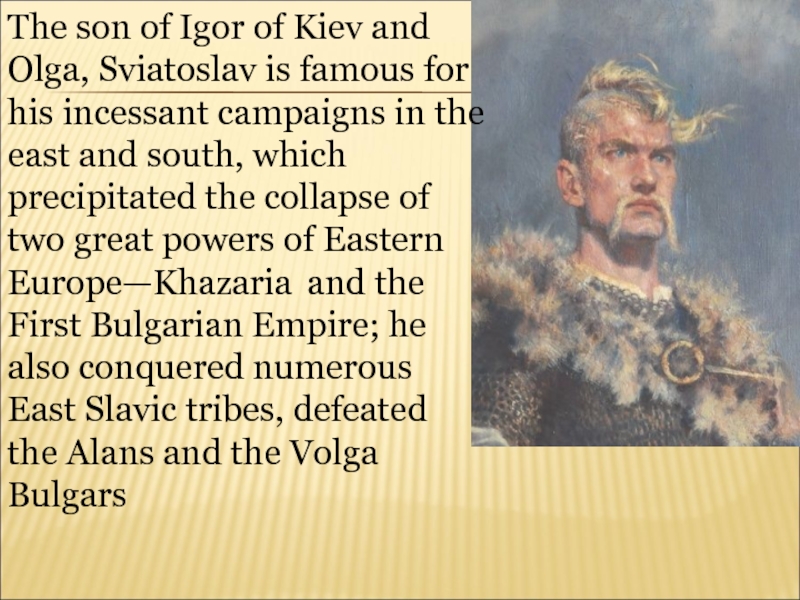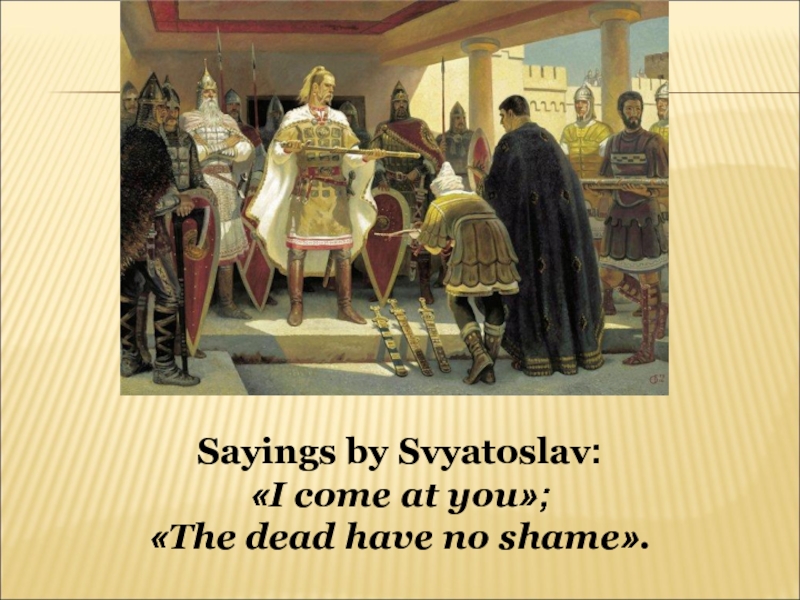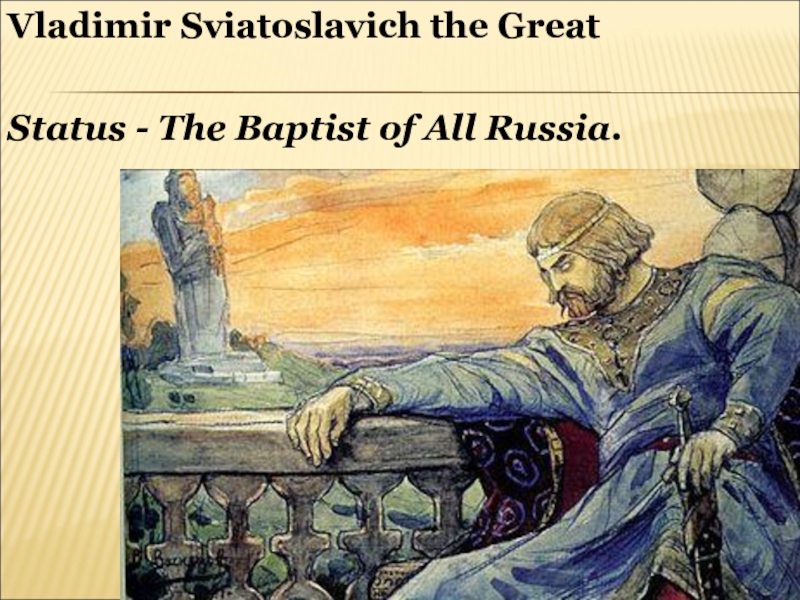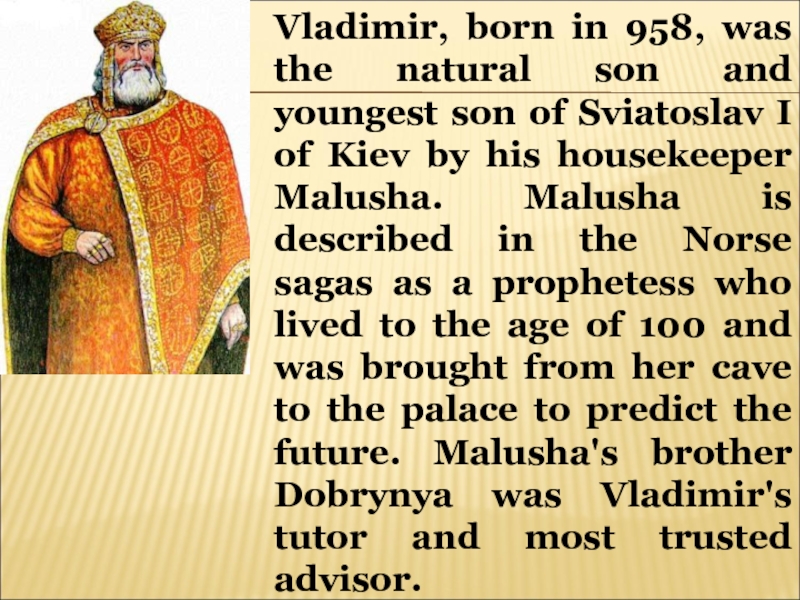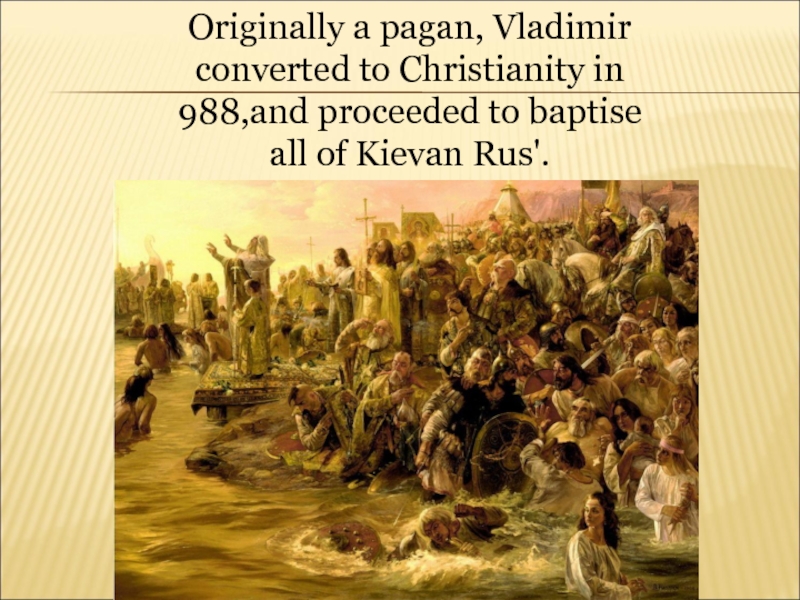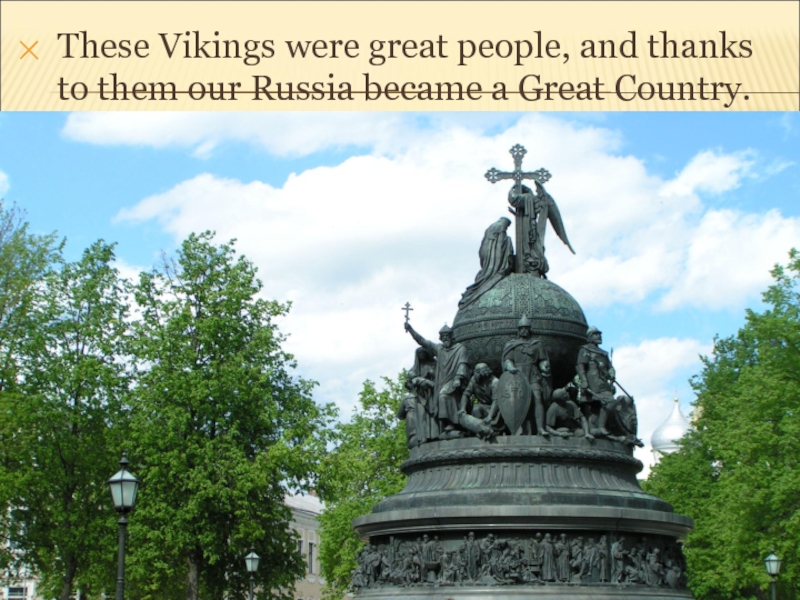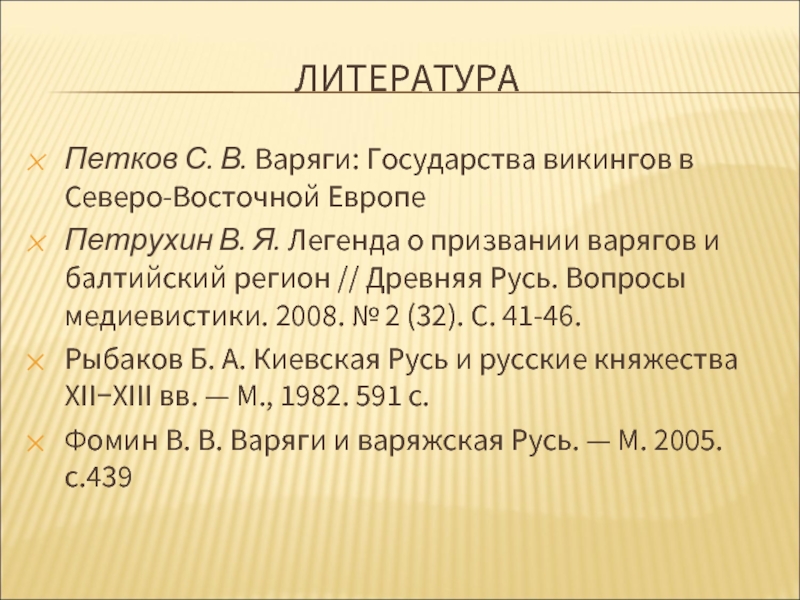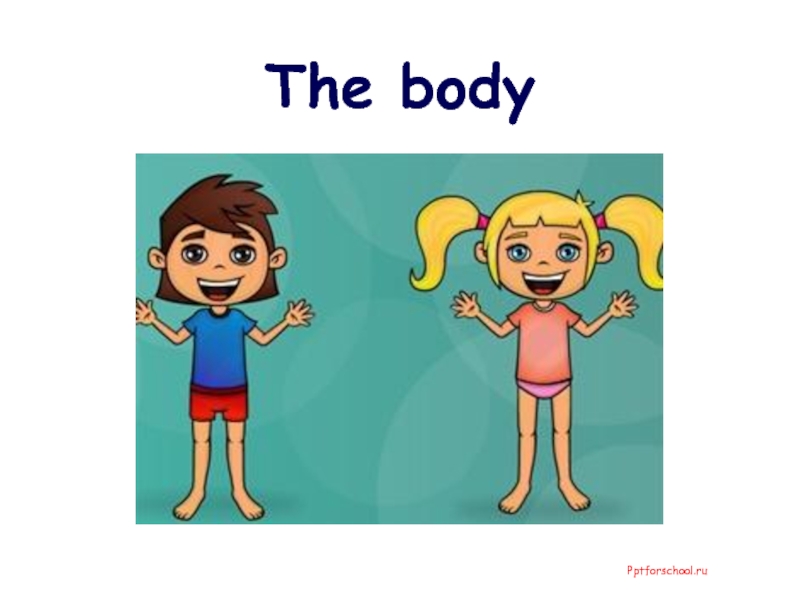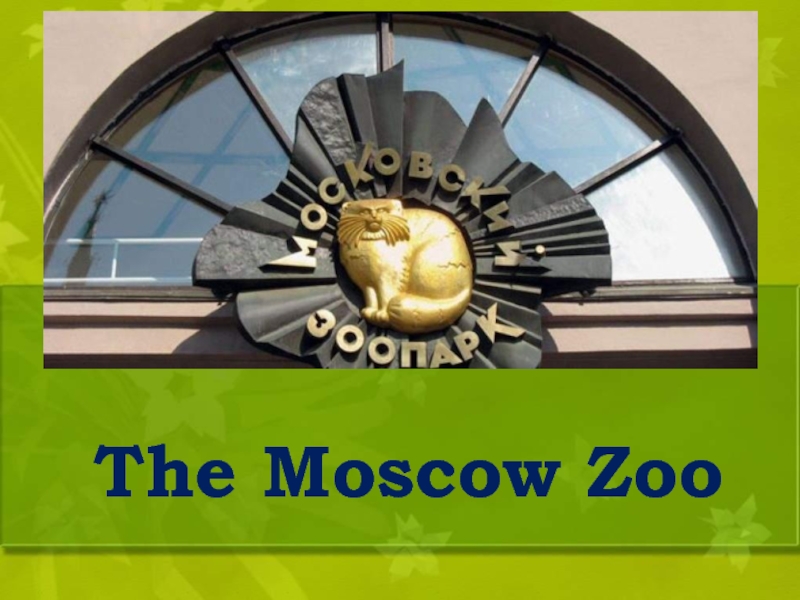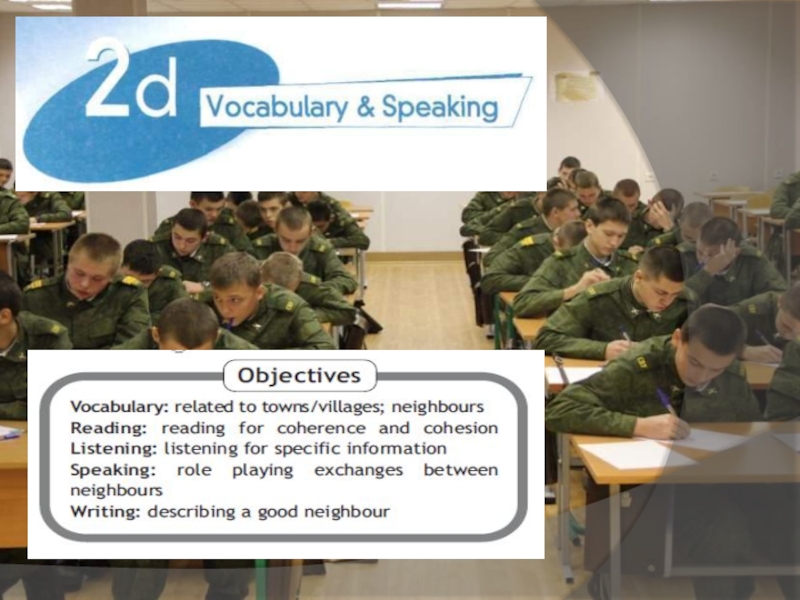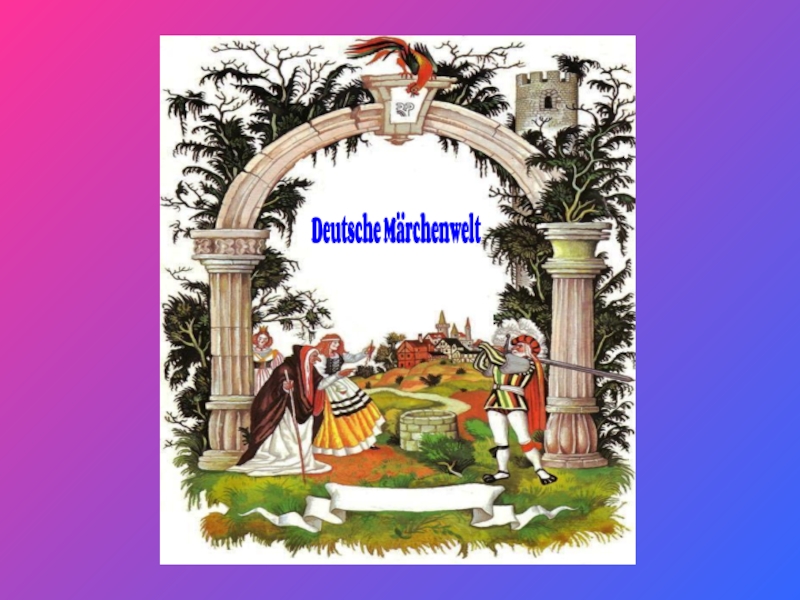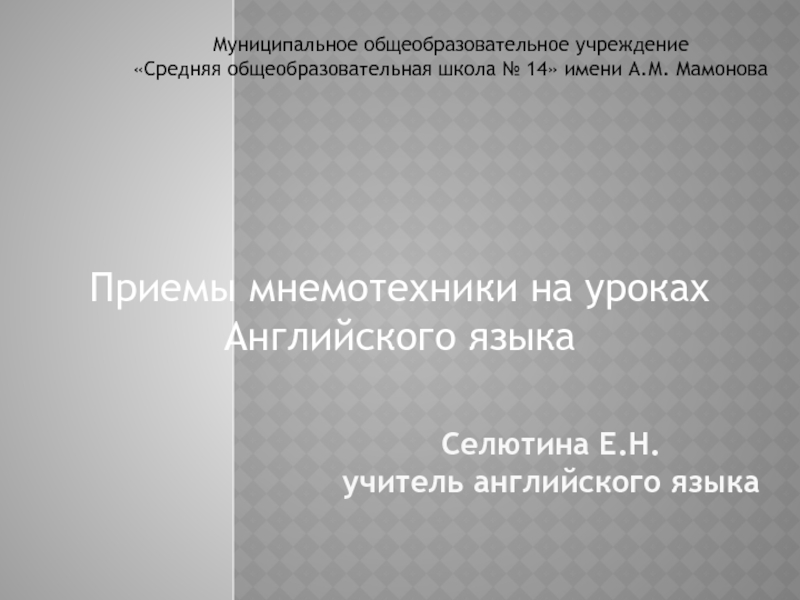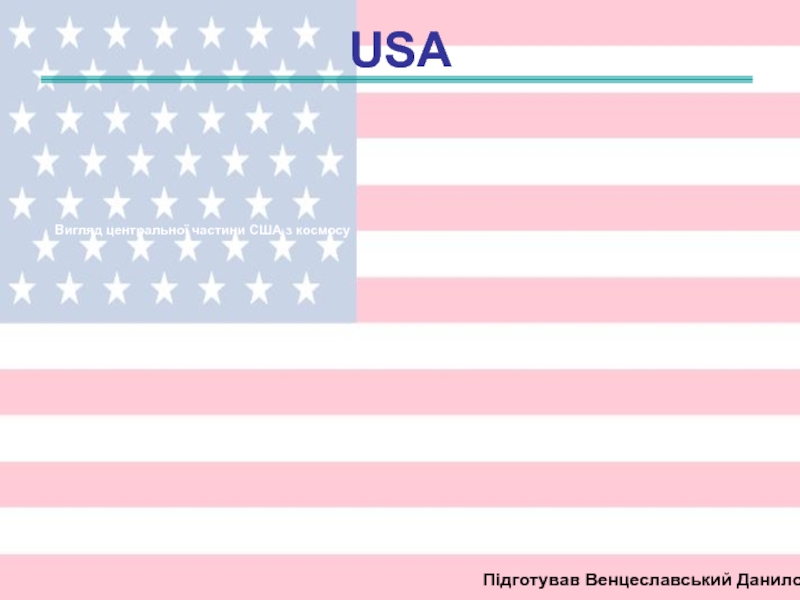Слайд 1Муниципальное бюджетное общеобразовательное учреждение
«Средняя общеобразовательная школа с.Черный Яр»
Тема проекта:
Автор:
Калюжный Николай 10 Б класс
Руководитель: учитель английского языка Илюхина С.В.
Место работы: МБОУ «СОШ с. Черный Яр»
Черный Яр , 2012
Творческое название проекта:
Seven Russian Vikings
Слайд 2The term Viking (from Old Norse víkingr) is customarily used
to refer to the Norse explorers, warriors, merchants, and pirates
who raided, traded, explored and settled in wide areas of Europe, Asia and the North Atlantic islands from the late 8th to the mid-11th century.
Слайд 3These Norsemen used their famed longships to travel as far
east as Constantinople and the Volga River in Russia, and
as far west as Iceland, Greenland, and Newfoundland. Thanks to them we were called Rus and got statehood
Слайд 4RURIK
Status - The founder of the Rurik dynasty and the
Russian state.
Rurik was a Varangian chieftain who gained control of
Ladoga in 862, built the Holmgard settlement near Novgorod, and founded the Rurik Dynasty which ruled Russia until the 17th century.
Слайд 5THE ONLY INFORMATION ABOUT HIM IS CONTAINED IN THE 12TH-CENTURY
RUSSIAN PRIMARY CHRONICLE, WHICH STATES THAT CHUDS, SLAVS, MERIAS, VESES
AND KRIVICHS "…DROVE THE VARANGIANS BACK BEYOND THE SEA, REFUSED TO PAY THEM TRIBUTE, AND SET OUT TO GOVERN THEMSELVES". AFTERWARDS THE TRIBES STARTED FIGHTING EACH OTHER AND DECIDED TO INVITE RURIK TO REESTABLISH ORDER.
Слайд 6Rurik Dynasty ruled Russia until the 17th century.
Слайд 7Status –the Father of "mother of Russian cities".
Oleg is
known as the Prophet (priest).
Слайд 8Oleg was a relative of the first ruler, Rurik, and
was entrusted by Rurik to take care of both his
kingdom and his young son Ingvar, or Igor. Oleg gradually took control of the Dnieper cities, captured Kiev and finally moved his capital from Novgorod.
Слайд 9The new capital was a convenient place to launch a
raid against Tsargrad (Constantinople) in 911. Having fixed his shield
to the gate of the imperial capital, Oleg won a favourable trade treaty, which eventually was of great benefit to both nations.
Слайд 10Oleg died under mysterious circumstances, and rather stupid. According to
this legend, it was prophesied by the pagan priests that
Oleg would take death from his stallion. Proud of his own foretelling abilities, he sent the horse away. Many years later he asked where his horse was, and was told it had died. He asked to see the remains and was taken to the place where the bones lay. When he touched the horse's skull with his boot a snake slithered from the skull and bit him. Oleg died, and completed a glorious career of the prince.
Слайд 11 IGOR
STATUS - THE MOST WELL-REVENGE RUSSIAN PRINCE.
IGOR WAS A
VARANGIAN RULER OF KIEVAN RUS' FROM 912 TO 945.
Слайд 12
He continued the work of Oleg- collecting tribute from neighboring
peoples. He did this not so successful. Igor was killed
while collecting tribute from the Drevlians in 945and was avenged by his wife, Olga of Kiev.
Слайд 13AS A RESULT, OLGA CHANGED THE SYSTEM OF TRIBUTE GATHERING
(POLIUDIE) IN WHAT MAY BE REGARDED AS THE FIRST LEGAL
REFORM RECORDED IN EASTERN EUROPE.
Слайд 14ASKOLD AND DIR
STATUS - LOVERS OF BEADS AND JEWELRY
Слайд 15Actually, they are two separate people, but they can be
considered for a single. The main losers of the initial
Russian history. Askold and Dir are semi-legendary rulers of Kiev who, according to the Primary Chronicle, were two of Rurik's voivodes in the 870s.
Слайд 16The Primary Chronicle relates that Askold and Dir were sanctioned
by Rurik to go to Constantinople. When travelling on the
Dnieper, they saw a settlement on a mountain. It was Kiev. Askold and Dir settled in the town and gathered a large number of fellow Varangians and began to rule the town and the land of the eastern Polans..
Слайд 17Oleg attacked and conquered Kiev around 882. According to the
Primary Chronicle he tricked and killed Askold and Dir.
Oleg
pretending to be ill, stayed in the boat and sent to Askold and Dir notice that he was taking a lot of beads and jewelry. When those Kievan princes went on board to evaluate the goods, Oleg introduced himself and his companion: "I am the Prince Oleg, and behold there Ryurikov prince Igor." And it was all over
Слайд 18TODAY THIS PLACE ON THE STEEP BANK OF THE DNIEPER
IS MARKED BY A MONUMENT CALLED ASKOLD'S GRAVE.
Слайд 19SINEUS AND TRUVOR
STATUS- "THEIR CLAN" AND "THEIR OWN DRUZHINA"
Слайд 20Sineus and Truvor were the brothers of Rurik.
According to
the Primary Chronicle, while Rurik settled in Novgorod, Sineous established
himself at Belo Ozero, on the shores of lake Beloye. Truvor established himself at Izborsk. Truvor and Sineus died shortly after the establishment of their territories. Rurik then consolidated these lands into his own territory and thus laid the foundations for the Kievan Rus'
Слайд 21
Sviatoslav I of Kiev
Status - "Alexander of Macedon our ancient
history." (Nikolai Karamzin, a Russian historian).
Слайд 22The son of Igor of Kiev and Olga, Sviatoslav is
famous for his incessant campaigns in the east and south,
which precipitated the collapse of two great powers of Eastern Europe—Khazaria and the First Bulgarian Empire; he also conquered numerous East Slavic tribes, defeated the Alans and the Volga Bulgars
Слайд 23
According to the Primary Chronicle: upon his expeditions he carried
with him neither wagons nor kettles, and boiled no meat,
but cut off small strips of horseflesh, game or beef, and ate it after roasting it on the coals. Nor did he have a tent, but he spread out a horse-blanket under him, and set his saddle under his head, and all his retinue did likewise
Sviatoslav was a blue-eyed male of average height but of stalwart build. He shaved his blond head and his beard but wore a bushy mustache and a sidelock as a sign of his nobility.
Слайд 24Sayings by Svyatoslav:
«I come at you»;
«The dead have no shame».
Слайд 25
Vladimir Sviatoslavich the Great
Status - The Baptist of All Russia.
Слайд 26
Vladimir, born in 958, was the natural son and youngest
son of Sviatoslav I of Kiev by his housekeeper Malusha.
Malusha is described in the Norse sagas as a prophetess who lived to the age of 100 and was brought from her cave to the palace to predict the future. Malusha's brother Dobrynya was Vladimir's tutor and most trusted advisor.
Слайд 27
Vladimir was baptized at Cherson, taking the Christian name of
Basil
Слайд 28
Returning to Kiev in triumph, he destroyed pagan monuments and
established many churches, starting with the splendid Church of the
Tithes (989) and monasteries on Mt. Athos.
Слайд 29
Originally a pagan, Vladimir converted to Christianity in 988,and proceeded
to baptise all of Kievan Rus'.
Слайд 30These Vikings were great people, and thanks to them our
Russia became a Great Country.
Калюжный Николай 10 Б класс
Руководитель:
Илюхина С.В.
Контакт:
Астраханская область, МБОУ «СОШ с. Черный Яр»,
тел. (8512) 2-11-40,
e-mail: school_sveta@mail.ru
КОНТАКТНАЯ ИНФОРМАЦИЯ
Слайд 32ЛИТЕРАТУРА
Петков С. В. Варяги: Государства викингов в Северо-Восточной Европе
Петрухин В. Я. Легенда
о призвании варягов и балтийский регион // Древняя Русь. Вопросы
медиевистики. 2008. № 2 (32). С. 41-46.
Рыбаков Б. А. Киевская Русь и русские княжества XII−XIII вв. — М., 1982. 591 с.
Фомин В. В. Варяги и варяжская Русь. — М. 2005. с.439
